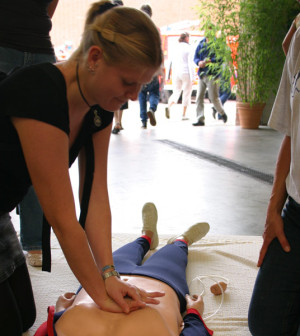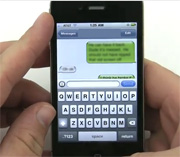- Navigating Your Midlife Crisis: Embracing New Possibilities
- City Raccoons Showing Signs of Domestication
- Mapping the Exposome: Science Broadens Focus to Environmental Disease Triggers
- One Week Less on Social Media Linked to Better Mental Health
- Your Brain Changes in Stages as You Age, Study Finds
- Some Suicide Victims Show No Typical Warning Signs, Study Finds
- ByHeart Formula Faces Lawsuits After Babies Sickened With Botulism
- Switch to Vegan Diet Could Cut Your Greenhouse Gas Emissions in Half
- Regular Bedtime Does Wonders for Blood Pressure
- Dining Alone Could Mean Worse Nutrition for Seniors
Early CPR Spurred by Smartphone Alerts Saves Lives


Starting cardiopulmonary resuscitation early and using smartphone alerts to increase rates of bystander CPR can save people with cardiac arrest, two new studies find.
When CPR was started before an ambulance arrived, twice as many cardiac-arrest patients lived to leave the hospital than when CPR was delayed, researchers said. And alerting people trained in CPR that their help was needed nearby greatly increased the rate of early CPR.
“We have proved what has been thought before — that early CPR is associated with improved survival,” said lead researcher Dr. Jacob Hollenberg, from the department of cardiology at South Hospital at the Karolinska Institute in Stockholm.
He said a mobile phone app that alerted laypeople trained in CPR that their help was needed nearby increased the rate of early CPR by 30 percent.
Both studies were published June 11 in the New England Journal of Medicine.
Cardiac arrest, which is not the same as heart attack, occurs when the heart suddenly stops working properly. In the United States, emergency medical services respond to more than 420,000 out-of-hospital cardiac arrests each year, according to the American Heart Association.
In one of the new studies, researchers analyzed over 30,000 out-of-hospital cardiac arrests that occurred in Sweden between 1990 and 2011. When CPR was started before an ambulance arrived, 10.5 percent of the patients survived at least 30 days, compared with 4 percent of patients who did not receive early CPR.
To get more trained people to the victim faster, Hollenberg’s team used a mobile-phone positioning system to locate volunteers within one-third of a mile. The alert was activated when ambulance, fire, and police were dispatched.
To test the system’s value, they alerted only some of the thousands of trained volunteers. They found that the rate of early CPR was 62 percent when volunteers were alerted by phone, compared with 48 percent when they weren’t.
Hollenberg believes this phone-alert system can be used in many countries, including the United States. “This is a way of using technology to increase bystander CPR,” he said.
The next step is to use the phone system to tell volunteers the location of the nearest defibrillator, Hollenberg said. CPR combined with early defibrillation has been shown to save more lives than CPR alone, he explained.
“People will not only be able to give CPR, but fetch the nearest defibrillator,” he said.
Dr. Comilla Sasson, an emergency medicine doctor at the University of Colorado School of Medicine, also thinks the phone system would work in American communities.
“Currently, we train millions of people every year in CPR but have no way to integrate them into the emergency response system,” said Sasson, co-author of an accompanying journal editorial.
“If we are going to increase bystander CPR rates, we must utilize the many willing volunteers we have trained in CPR, empower them to act in an emergency situation, and most importantly make it the norm that all cardiac arrest victims have an opportunity to survive no matter where they have their arrest,” Sasson said.
Americans are accustomed to using mobile phones to find coffee, hail cabs and see if their friends are close by, she said. This use of mobile phone technology along with integration of volunteers into the 911 system may help get CPR-trained bystanders to the right place at the right time, Sasson said.
“Although we have a deeply fragmented 911 system, and concerns about liability, we must overcome these barriers and test how a mobile phone intervention, such as the one in Sweden, can help us increase the use of bystander CPR,” she said.
More information
For more on CPR, visit the American Heart Association.
Source: HealthDay
Copyright © 2025 HealthDay. All rights reserved.










